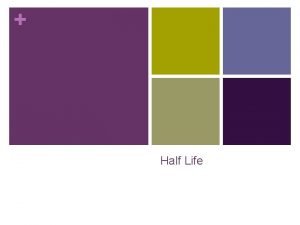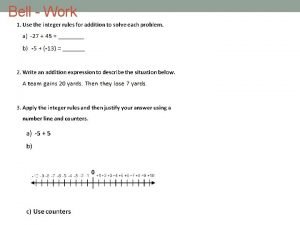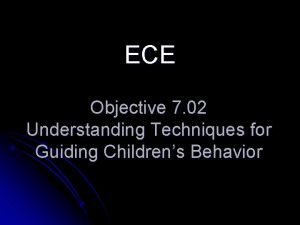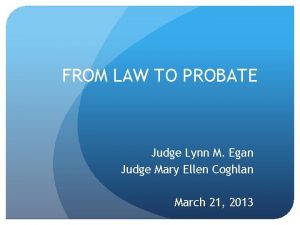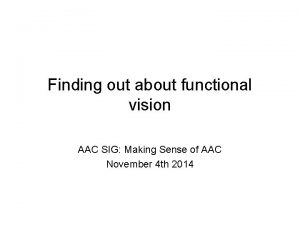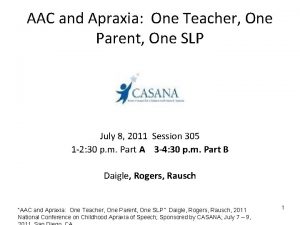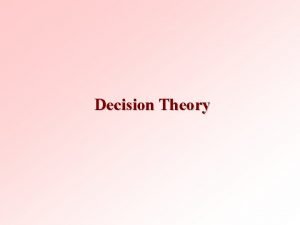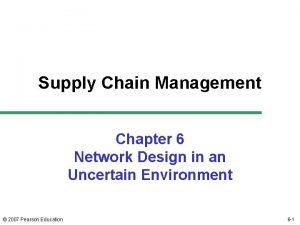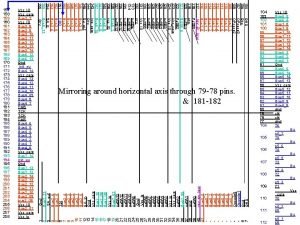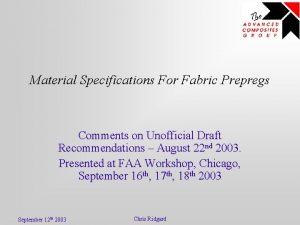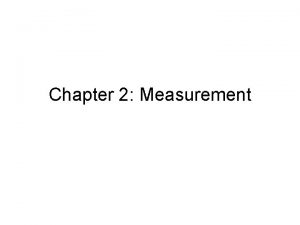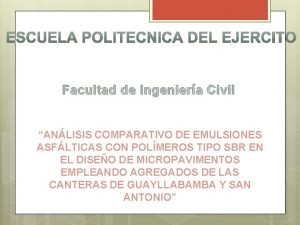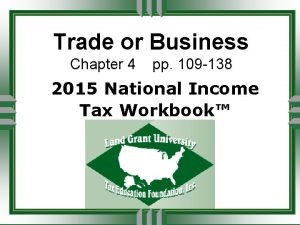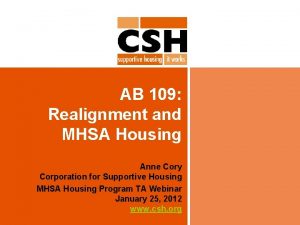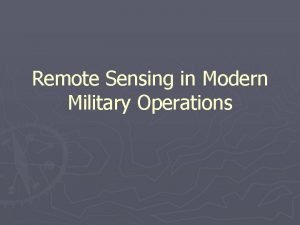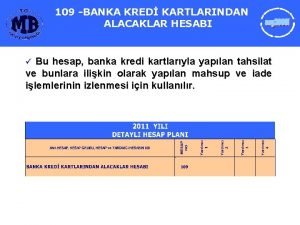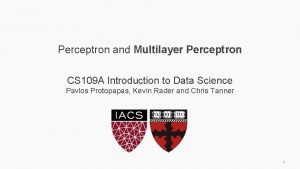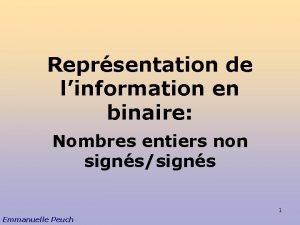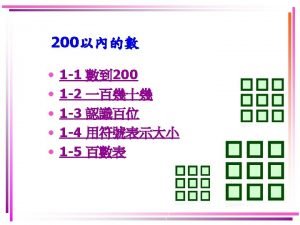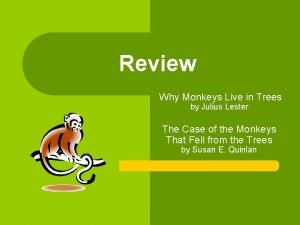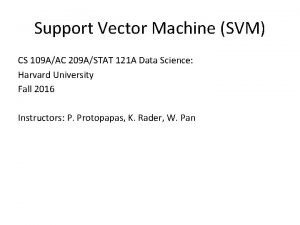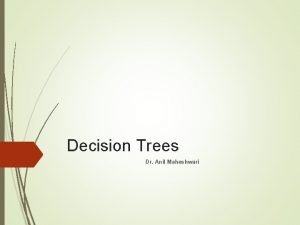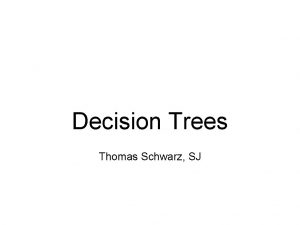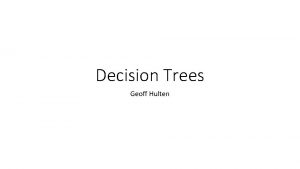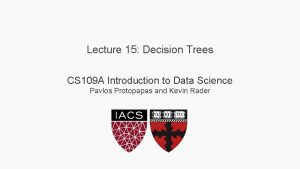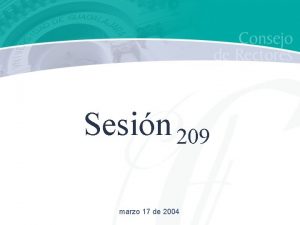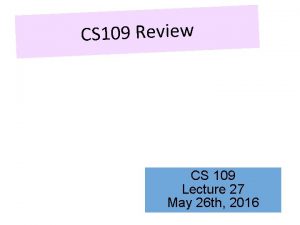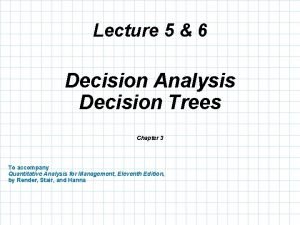Lecture 15 Decision Trees CS 109 AAC 209


























































- Slides: 58

Lecture 15. Decision Trees¶ CS 109 A/AC 209 A/STAT 121 A Data Science: Harvard University Fall 2016 Instructors: P. Protopapas, K. Rader, W. Pan

Announcements • Projects. Milestone 3 is due Saturday • HW 5 solutions coming soon. Few students had medical emergencies so we will not release until everyone is done

Quiz Code: willbyers

Outline Tree based methods Regression Trees Classification Trees Bagging

Outline Tree based methods Regression Trees Classification Trees Bagging

Tree-based methods

Basic Idea

x 2 Region 1 x 2 a Region 3 x 1 a x 1

x 1>x 1 a X 1<x 1 a X 2<x 2 a x 2>x 2 a

Basic Idea Segment the predictor space into sub-regions and we learn from the training set the value to predict as the mean or mode or median of the respond variable of the training examples that are in that segment.

Why Trees? What would you do tonight? Decide amongst the following: • Finish homework • Go to a party • Read a book • Hang out with friends

Homework Deadline tonight? No Do homework Party invitation? Yes No Go to the party Do I have friends No Read a book Yes Hang out with friends

Why Trees? We split the predictor space as brunches of a tree and therefore these methods are called decision tree methods

Why Forest? Not the most powerful models but using multiple trees as in bagging, random forests and boosting yield much better results.

Outline Tree based methods Regression Trees Classification Trees Bagging

Regression Build a regression tree: Divide the predictor space into J distinct not overlapping regions R 1, R 2, R 3, …, RJ We make the same prediction for all observations in the same region; use the mean of responses for all training observations that are in the region

x 2 Region 1 y=2. 2 y=3. 2 Region 3 y=5. 6 x 1

Finding the sub-regions The regions could have any shape. But we choose just rectangles x 2 Region 1 y=2. 2 Y=2. 5 Y=2. 9 Region 3 Y=3. 2 Y=5. 1 y=5. 6 x 1

Find boxes R 1, . . . , RJ that minimize the RSS where is the mean response value of all training observations in the Rj region This computationally very expensive! Solution: Top down approach, greedy approach recursive binary splitting

Recursive Binary Splitting 1. Consider all predictor Xp and all the all possible values of the cutpoints s for each of the predictors. Choose the predictor and cutpoint s. t. it minimizes the RSS This can be done quickly, assuming number of predictors is not very large 2. Repeat #1 but only consider the sub-regions 3. Stop: node contains only one class or node contains less than n data points or max depth is reached


Overfitting If we keep splitting we will be reducing RSS

Pruning Fewer splits or fewer regions lower variance better interpretation at cost of little more bias Ideas? Stop splitting when RSS improvement is lower than a threshold Smaller trees but not effective (short sighted) A split early on in the tree might be followed by a very good split; a split that leads to a large reduction in RSS later on

Pruning Better is to grow a large tree and then look subtrees that minimize the test error How? Cross-validation of all possible subtrees? This is too expensive Cost complexity pruning—also known as weakest link pruning

Cost complexity pruning Consider a tuning parameter a that for each value of a there is a subtree that minimizes Where |T| is the number of terminal nodes. a controls the complexity of the tree similarly we saw with other regularizations (e. g. LASSO). It turns out that as we increase α from zero in, branches get pruned from the tree in a nested and predictable fashion, so obtaining the whole sequence of subtrees as a function of α is easy.

ALGORITHM FOR PRUNING 1. Use recursive binary splitting to grow a large tree on the training data, stopping only when each terminal node has fewer than some minimum number of observations 2. Apply cost complexity pruning to the large tree in order to obtain a sequence of best subtrees, as a function of α 3. Use K-fold cross-validation to choose α – Repeat #1 and #2 on the k-th fold – Estimate the MSE as a function of α Average all and pick α 4. Return the subtree from Step 2 that corresponds to the chosen value of α

Hitters data set: Response variable: baseball player’s Salary Predictors: – Years (the number of years that he has played in the major leagues) – Hits (the number of hits that he made in the previous year) – Walks, RBI, hits, putouts Note: log-transform Salary so that its distribution has more of a typical bell-shape.



Outline Tree based methods Regression Trees Classification Trees Bagging

Classification Trees Very similar to regression except that it is used to predict a qualitative response rather than a quantitative one In regression trees we use the mean response of the training observations for classification trees we use most commonly occurring class Interested in the class proportions of each region

Classification Trees We learn the model using recursive binary splitting as with the regression trees except … RSS cannot be used as a criterion for making the binary splits. Classification error rate: represents the proportion of training observations in the m-th region that are from the k-th class

Gini index Classification error is not differentiable or sensitive enough for tree growing. Purity of the nodes, Gini index G takes small values when pmk is small or close to 1, therefore is a measure of purity of the nodes.

Gini index Example: 5 red, 2 blue and 3 green red: 5/10*(1 -5/10) = 0. 25 blue: 2/10*(1 -2/10) = 0. 16 green: 3/10*(1 -3/10) = 0. 21 G=0. 61

Misclassification Example: 5 red, 2 blue and 3 green Proportions pmk for each class are: 5/10, 2/10, 3/10 maxk(pmk) = 5/10 Classification error E = 1 -1/2=1/2

Cross entropy Alternative to the Gini index is cross entropy D>0 and will take value near zero when pmk is either near zero or one

Node impurity for two class problem Hastie et al. , ”The Elements of Statistical Learning: Data Mining, Inference, and Prediction”, Springer (2009)

Node Purity Gain Compare: – Gini impurity of parent node – Gini impurity of child nodes A B C

Pruning classification Tree • Use the same algorithm as for regression tree but instead of RSS use Gini index or Entropy HOWEVER: classification error rate is preferable for the final pruned tree

Example: Heart data set • 303 patients who presented with chest pain • Response takes values Yes/No indicates the presence of heart disease • 13 predictors including Age, Sex, Chol (a cholesterol measurement), and other heart and lung function measurements Cross validation


Comparison to linear models

Outline Tree based methods Regression Trees Classification Trees Bagging

Advantages of tree based methods • Easy to explain • Handle qualitative predictors • Display graphically and easy to interpret • More similar to human decision making

Disadvantages • Non robust. Sensitive to small changes in the data • Trees generally do not have the same level of predictive accuracy as some of the other regression and classification approaches we have seen • Only axis aligned splits

Power of the crowds • Wisdom of the crowds http: //www. scaasymposium. org/portfolio/part-v-the-power-of-innovation-and-the-market/

Ensemble methods • A single decision tree does not perform well • But, it is super fast • What if we learn multiple trees? We need to make sure they do not all just learn the same

Bagging If we split the data in random different ways, decision trees give different results, high variance. Bagging: Bootstrap aggregating is a method that result in low variance. If we had multiple realizations of the data (or multiple samples) we could calculate the predictions multiple times and take the average of the fact that averaging multiple onerous estimations produce less uncertain results

Bagging Say for each sample b, we calculate fb(x), then: How? Bootstrap Construct B (hundreds) of trees (no pruning) Learn a classifier for each bootstrap sample and average them Very effective

Bagging for classification: Majority vote Test error

Out-of-Bag Error Estimation • No cross validation? • Remember, in bootstrapping we sample with replacement, and therefore not all observations are used for each bootstrap sample. On average 1/3 of them are not used! • We call them out-of-bag samples (OOB) • We can predict the response for the i-th observation using each of the trees in which that observation was OOB and do this for n observations • Calculate overall OOB MSE or classification error

X 2 X 1

Bagging decision trees Hastie et al. , ”The Elements of Statistical Learning: Data Mining, Inference, and Prediction”, Springer (2009)

Bagging • Reduces overfitting (variance) • Normally uses one type of classifier • Decision trees are popular • Easy to parallelize

Variable Importance Measures • Bagging results in improved accuracy over prediction using a single tree • Unfortunately, difficult to interpret the resulting model. Bagging improves prediction accuracy at the expense of interpretability. Calculate the total amount that the RSS or Gini index is decreased due to splits over a given predictor, averaged over all B trees.


Different flavors • ID 3, or alternative Dichotomizer, was the first of three Decision Tree implementations developed by Ross Quinlan (Quinlan, J. R. 1986. Induction of Decision Trees. Mach. Learn. 1, 1 (Mar. 1986), 81 -106. ) • C 4. 5, Quinlan's next iteration. The new features (versus ID 3) are: (i) accepts both continuous and discrete features; (ii) handles incomplete data points; (iii) solves over-fitting problem by (very clever) bottom-up technique usually known as "pruning"; and (iv) different weights can be applied the features that comprise the training data. Used in orange http: //orange. biolab. si/ • CART or Classification And Regression Trees is often used as a generic acronym for the term Decision Tree, though it apparently has a more specific meaning. In sum, the CART implementation is very similar to C 4. 5; the one notable difference is that CART uses the Gini index. Used in sklearn

Further reading • Pattern Recognition and Machine Learning, Christopher M. Bishop • The Elements of Statistical Learning Trevor Hastie, Robert Tibshirani, Jerome Friedman http: //statweb. stanford. edu/~tibs/Elem. Stat. Learn/printings/E SLII_print 10. pdf
 No decision snap decision responsible decision
No decision snap decision responsible decision Financial management process
Financial management process Whats half of 209
Whats half of 209 Lesson 2 add integers page 209 answers
Lesson 2 add integers page 209 answers Ece 209
Ece 209 Ece 209
Ece 209 In my heart there rings a melody
In my heart there rings a melody Presente activo
Presente activo 735 ilcs 5/13-209
735 ilcs 5/13-209 01:640:244 lecture notes - lecture 15: plat, idah, farad
01:640:244 lecture notes - lecture 15: plat, idah, farad Aac goals
Aac goals Aac sig
Aac sig Aac
Aac Adec 18 aac 75
Adec 18 aac 75 Aac implementation plan
Aac implementation plan Aac implementation plan
Aac implementation plan Air armament center
Air armament center Tips for augmentative and alternative communication success
Tips for augmentative and alternative communication success Coverage vocabulary aac
Coverage vocabulary aac Winamp aac encoder
Winamp aac encoder Aac feature matching
Aac feature matching Augmentative and alternative communication profile
Augmentative and alternative communication profile Tertiary aac assessment centre
Tertiary aac assessment centre Amazon oxygen production
Amazon oxygen production It acquisition advisory council
It acquisition advisory council Aac and apraxia
Aac and apraxia No tech aac examples
No tech aac examples Crooked house aac
Crooked house aac Visual scene displays aac
Visual scene displays aac Decision theory
Decision theory Describe data and process modeling concepts and tools
Describe data and process modeling concepts and tools Network design decisions using decision trees
Network design decisions using decision trees Sargur srihari
Sargur srihari Bayesian decision theory lecture notes
Bayesian decision theory lecture notes Guia tecnica radiacion uv
Guia tecnica radiacion uv Leucosolenia slide
Leucosolenia slide 105 106 107
105 106 107 Dot/faa/ar-02/110
Dot/faa/ar-02/110 Difference between fas 109 and asc 740
Difference between fas 109 and asc 740 100000/109
100000/109 Chem 109
Chem 109 Issa tb 109
Issa tb 109 Xm 109
Xm 109 Psalm 109 1-31
Psalm 109 1-31 Underfit reviews
Underfit reviews 109+138
109+138 Ab 109 housing
Ab 109 housing Lampiran permendagri 109 tahun 2019 word
Lampiran permendagri 109 tahun 2019 word Bp 109/64
Bp 109/64 Electrical 1 module 9 conductors and cables
Electrical 1 module 9 conductors and cables Is 109 a prime number
Is 109 a prime number Bgm 109
Bgm 109 109 hesap
109 hesap Cs 109
Cs 109 125 en binaire
125 en binaire 101 102 103 104 105 106 107 108 109 110
101 102 103 104 105 106 107 108 109 110 Decision tree and decision table
Decision tree and decision table Monkeys live in or on trees
Monkeys live in or on trees Candle personification
Candle personification


